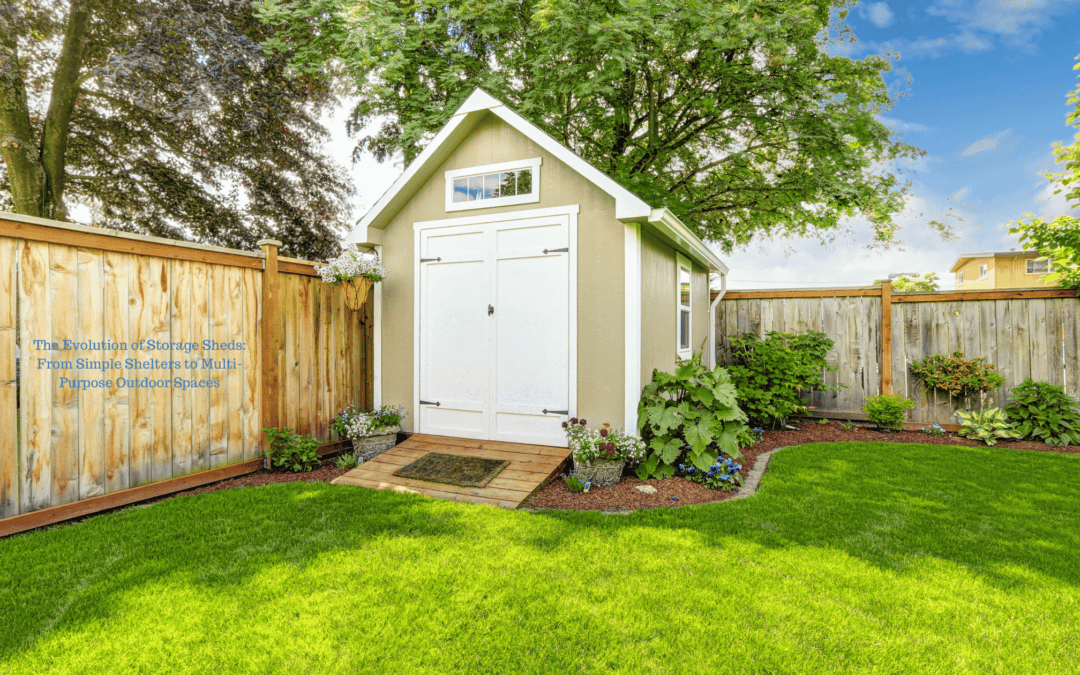Storage sheds have come a long way from their humble origins as basic shelters for storing tools and equipment. Today, these outdoor structures serve as versatile spaces that can be customized to fit a variety of needs, from home offices to recreational areas. In this blog post, we will explore the evolution of storage sheds, from their early origins to the multi-purpose outdoor spaces they have become in modern times.
Early Origins of Storage Sheds
The history of storage sheds can be traced back to ancient civilizations, where simple structures were used for storing food and supplies. These early sheds were often made from natural materials such as wood or thatch and provided basic shelter from the elements. As societies evolved, so did the design and function of storage sheds, with more structured designs emerging over time. In medieval Europe, sheds were used to house livestock and store agricultural equipment.
The Rise of the Modern Storage Shed
During the industrial revolution, there was a significant shift in the way storage sheds were constructed. Standardized designs and materials became more prevalent, making it easier and more cost-effective to build outbuildings for storage purposes. This marked the beginning of the modern era of storage shed construction, with more emphasis on durability and functionality. However, these sheds were still primarily used for storage and were not yet considered multi-purpose spaces.
Innovations in Design and Functionality
In recent years, advancements in technology and manufacturing have revolutionized the storage shed industry. Prefabrication techniques allow for quick and easy assembly, while modular construction offers flexibility in design options. Customizable features such as windows, doors, and shelving systems have made it possible to tailor storage sheds to specific needs and preferences.
The Evolution Toward Versatility and Style
Modern storage sheds have transcended their utilitarian roots to become versatile extensions of living spaces. Today, these structures are not only designed for storage but also adapted for workshops, home offices, gyms, and even guest houses. This shift in functionality is complemented by aesthetic advancements, with sheds now available in a variety of architectural styles to match or enhance the visual appeal of existing property.
Materials too have evolved, with options ranging from traditional wood and metal to modern vinyl and composite materials, offering durability and minimal maintenance. This blend of style, versatility, and functionality signifies a new era in the perception and use of storage sheds, marking them as valuable assets for augmenting living spaces and lifestyle needs.
Beyond Storage: The Multi-Purpose Shed
One of the most exciting trends in modern storage shed design is the transformation of these structures into multi-purpose outdoor spaces. Homeowners are now using sheds as home offices, workshops, gyms, and even recreational areas. With some creativity and ingenuity, a simple storage shed can become a functional extension of your living space.
The Personalization of Outdoor Spaces
This evolution towards multi-functional sheds reflects a broader trend in personalizing outdoor areas to meet diverse lifestyle demands. The adaptability of shed designs allows for seamless integration into outdoor living spaces, adding value and functionality to homes. For instance, garden enthusiasts can transform these sheds into greenhouses or potting stations, while artists may use them as secluded studios, brimming with natural light. This versatility not only enhances the usability of outdoor spaces but also promotes a healthier work-life balance by providing a dedicated area for hobbies, work, or relaxation away from the main living area. Furthermore, the increasing preference for sustainable living has seen the incorporation of eco-friendly materials and features, such as solar panels and rainwater collection systems, into shed designs. This shift not only reflects an awareness of environmental impact but also offers the potential for energy savings and sustainability.
Sustainable Shed Solutions
As environmental consciousness grows, there is a greater emphasis on eco-friendly and sustainable shed design practices. Renewable materials such as bamboo and reclaimed wood are being used in shed construction, while energy-efficient features like solar panels and insulation help reduce environmental impact. By choosing sustainable shed solutions, homeowners can enjoy their outdoor spaces while minimizing their carbon footprint.
Future Trends and Possibilities
The future of storage shed design and usage is poised for innovative transformations, with smart technology integration leading the way. Imagine sheds equipped with IoT (Internet of Things) devices that can monitor interior conditions, automate lighting, heating, and cooling based on weather changes, and even alert homeowners to maintenance needs. Off-grid capabilities, such as solar-powered sheds with battery storage systems, are becoming increasingly feasible, enabling sheds to serve as self-sufficient workspaces or leisure areas, further reducing the carbon footprint of households.
Multifunctional spaces will continue to evolve, with sheds potentially serving dual purposes as greenhouses, rainwater collection systems, or even compact guest houses. This flexibility is particularly appealing in the context of urban planning, where space is at a premium. Sheds could play a significant role in sustainable living initiatives, offering solutions for compact living environments, community gardening, and local food production.
In urban areas, the adaptation of shed designs to include vertical gardens or living roofs could contribute to biodiversity, improve air quality, and lower urban heat islands. These structures can become integral parts of eco-friendly city planning, combining utility with environmental stewardship.
The potential for sheds to enhance sustainable living and contribute to thoughtful urban planning is vast. By integrating advanced technologies, sustainable materials, and multifunctional designs, sheds can transcend their traditional roles and become pivotal in creating more sustainable and adaptable living environments.
Conclusion
The evolution of storage sheds from simple shelters to multi-purpose outdoor spaces showcases how far these structures have come in meeting our ever-changing needs. Whether you use your shed for traditional storage purposes or transform it into a creative workspace or leisure area, there is no limit to what these versatile structures can offer. With an eye towards sustainability and innovation, the future looks bright for the world of storage sheds.


Recent Comments